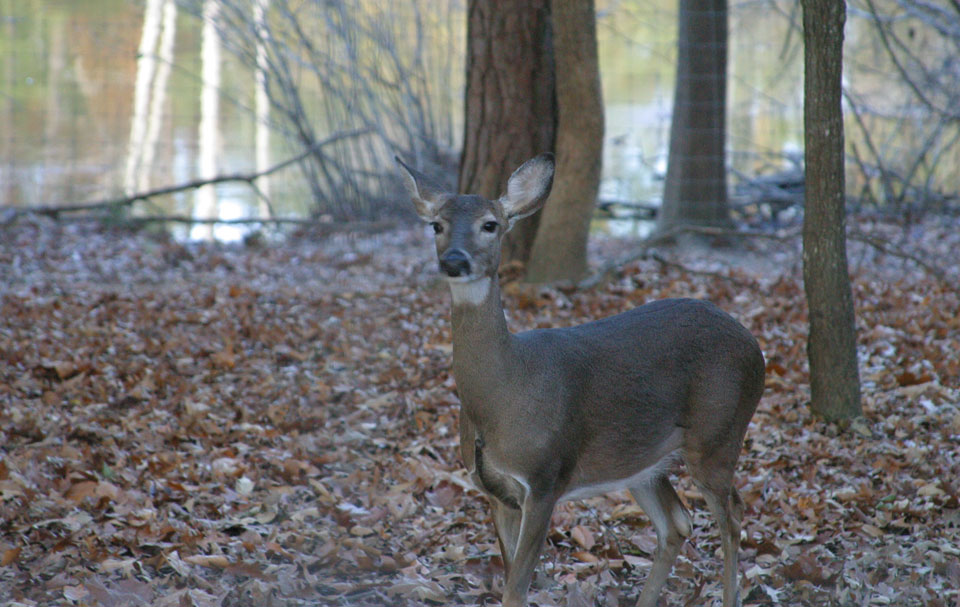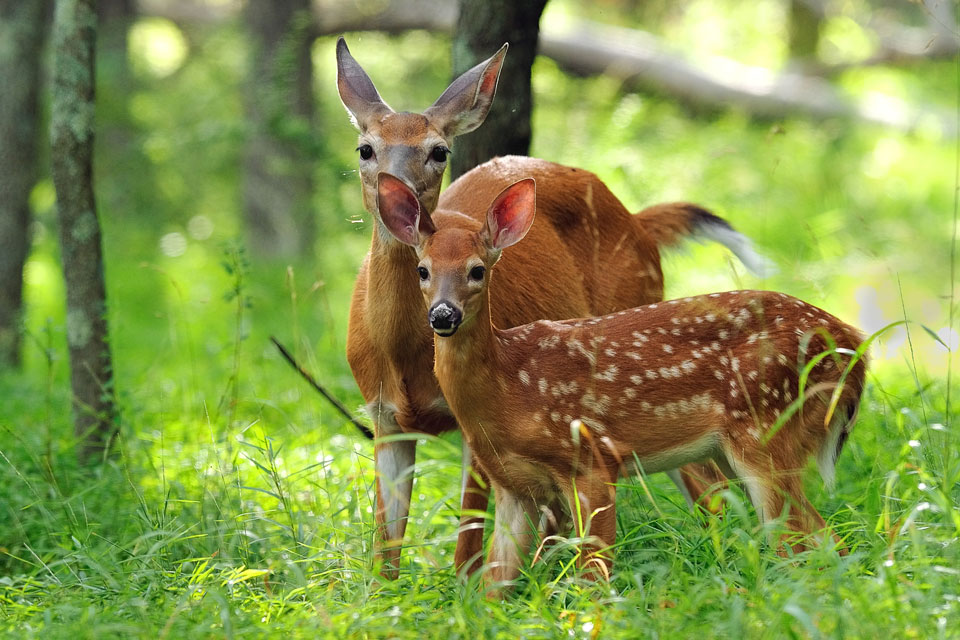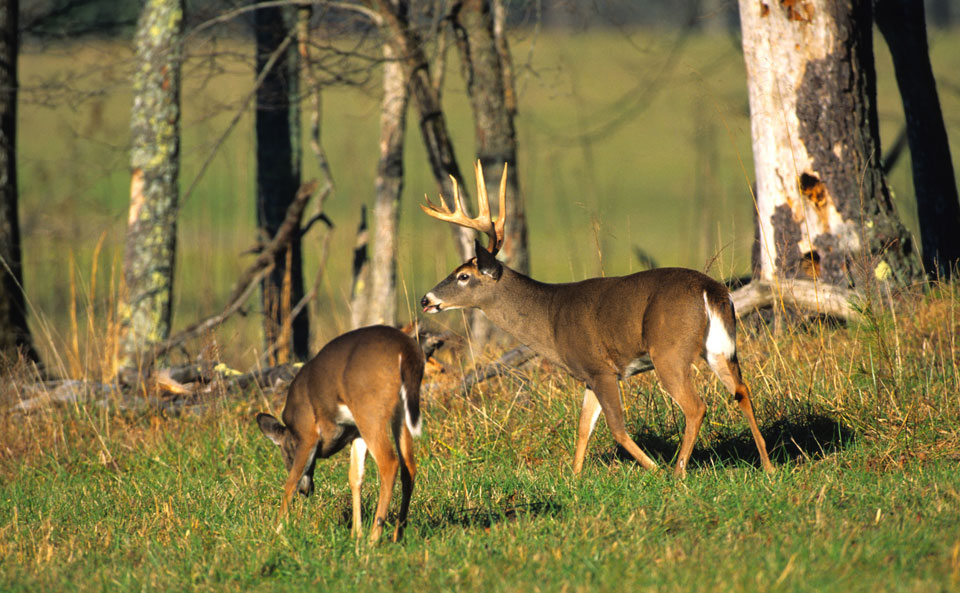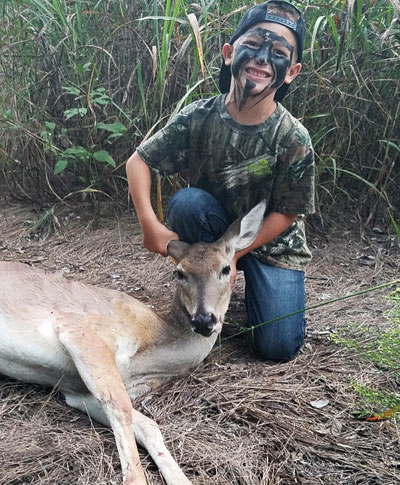Andrew Walters | Originally published in GameKeepers: Farming for Wildlife Magazine
The season opener has finally arrived and you can’t stop thinking of the buck you have been watching all summer. You’ve spotted him and his bachelor group several times throughout the year and let him walk as a younger buck during prior hunting seasons. Focusing on the possibility of tagging your target buck has influenced you to let more than a fair share of does walk past your setup, all the while robbing your herd’s quality. After all, who wants to harvest does and jeopardize their chance of killing a buck that would accent their trophy room nicely? However, deer management professionals must realize in order to exploit the maximum potential of their herd they must first focus on harvesting does. The truth is “antlerless deer harvest” is one of the most vital aspects of managing your herd correctly and many managers believe this should be done as early as possible in the season.

How Many Does Need to Be Removed?
The first item on a gamekeeper’s agenda should be figuring out approximately how many does need to be removed. This varies greatly from year to year and some parcels of land will require a different quota than other parcels of land just a few miles away. It will also differ depending upon the individual land owner’s goals. The exact number of does to be shot is not set in stone, so focusing on deriving a sustainable number to be removed is imperative. Taking too many does will obviously reduce your deer sightings resulting in dull hunts. On the other hand, shooting too few does each year isn’t likely to benefit the herd much at all and could actually harm fawn recruitment the following spring.
Timber management, water sources, agricultural crops, food plots, bedding cover and the acreage of land allocated to these areas are all factors that affect the number of deer on an individual piece of property. Your local biologist or wildlife consultant can help you to figure out a number that you feel comfortable with that will maximize the potential of your herd. The Quality Deer Management Association’s “Deer Cameras: The Science of Scouting” is a great resource for a do-it-yourself trail camera survey that should give you an accurate buck to doe ratio for your property.
Inconspicuous Thieves: Benefits of Early Doe Harvest
You may be wondering what the benefits of harvesting antlerless deer early in the season are, and there are probably more than you realized. Many gamekeepers and deer management experts have invested huge amounts of time and money into food plots and mast-producing trees that are strategically situated across their property. In some states feeding and/or baiting deer is also legal. Research at the University of Tennessee reports the average food plot costs approximately $150 to $200 per acre before the use of farm equipment, and supplemental feeding costs more than that when calculated per how many mouths you’re feeding. Doe harvest can have a big impact on your bottom line.

Harvesting the number of does on your hit list for the year early during the hunting season has a number of advantages. It saves you money, leaves more resources for the remainder of the herd and takes stress off of the bucks resulting in better antlers the following season.
Consider all the does harvested during the last few days of the hunting season, just before the season’s end. Now think about how many times those does visited your food plots and how many tons of resources they consumed throughout the season at your expense (and at the expense of the rest of the herd). At season’s end a doe was harvested, but wouldn’t it have been better for the remainder of your herd and more economical to harvest that doe earlier in the year? This would have allowed other deer that were not on your “hit list” to benefit from those consumed resources? Feeling robbed yet?
More Deer Require More Resources
These resources are valuable to all deer within the herd. Bucks use the minerals and nutrients for antler growth, skeletal development and to build reserves to survive the winter while does use them for lactation, fetal development and also survival. A mineral deficiency will affect the quantity of milk produced for the does. If the antlerless deer density is too high and there is a lack of resources, some does may not be able to nurse their fawns for the time necessary to send their fawns into life with optimum health, in fact, some can even abandon them if adequate nutrition isn’t available. Milk production is the most physiologically demanding state for does and an essential component of fawn recruitment. Therefore, it should be an important deer management consideration.
Your food plots are not the only type of forage that can be damaged by a high deer density. Deer can deplete the natural resources available to them in a short amount of time. There are many important types of native forages available to your herd. Hard mast crops such as white and red oaks, soft mast crops such as persimmons and apples, herbaceous plants such as pokeweed and shrubs such as beautyberry are just a few that whitetails will utilize.
Only a certain amount of native forage is produced per year and removing does earlier in the season will result in more food left for the herd through the winter. You may have seen the proverbial “browse line” about four to five feet high in areas where the native forage cannot keep up with the amount of mouths available. Where the problem exists, one can usually be seen essentially anywhere the deer can reach something remotely palatable from the forest floor through the shrub layer.
Browse lines on your property are an indication that your doe harvests need to be taken care of immediately. High deer densities can be detrimental to their habitat, which not only affects the deer, but also other coexisting wildlife. This is very important because it not only shapes the near term, but habitat degradation can be so severe that it changes the flora makeup forever. Early season doe harvest coupled with the supplementation of their natural diet via food plots and timber management is a great way to prevent this from ever becoming an issue.

Many studies have been conducted about the issue of “predator swamping.” With a healthy buck to doe ratio, the majority of the does are bred during their first estrus cycle and the fawns are all born during relatively the same timeframe the following spring. Theoretically, this makes it more difficult for predators to target all the fawns being born at the same time because they’re simply overwhelmed by numbers. In order for this to happen, only the does that you wish to leave in your herd should be around when the breeding occurs. Results vary from area to area and in some studies it showed high predator densities still resulted in a high fawn mortality, but in other instances it seemed to work in favor of fawn recruitment. Will it work on your property? Probably. This gives land managers even more incentive to tag their antlerless deer early, especially if the predator density is higher in your area.
What about the Bucks? How Doe Management Helps
Harvesting the adequate amount of antlerless deer can also positively affect the bucks. The rut is the time of year that hunters cannot wait for…and who can blame them?
Bucks driven by raging levels of testosterone spend hours cruising for does haphazardly, not paying any mind to that guy up a tree 20 yards away. The problem is this scenario doesn’t always occur like expected in areas of high antlerless deer densities. A prolonged rut can result in weeks of breeding opportunities instead of a short, intense, synchronized rut, making it difficult for hunters to figure out what phase of the rut they are currently observing and how they should hunt it. Tagging a trophy buck is tough enough; don’t make it any more difficult by not understanding what is going on within your deer herd.
It is common for a buck to spend hours following a female in estrus so he is indeed present when the time is right. During this process he exerts a tremendous amount of energy. If a bred doe is harvested later in the season that breeding buck was robbed of the energy he used pursuing and tending that doe – it was all for naught. Once again, the end result was one less doe, but the buck wasted a tremendous amount of energy that could have been spent tending another doe or put towards next year’s antler growth.

for some managers, especially in areas where tags are
restricted. Get everyone involved in your doe harvest — it’s
a great way to get youth or first time hunters involved.
Here, Anna Crossley poses with her first Mississippi deer
taken over a BioLogic Green Patch Plus field.
The does that will ultimately be harvested are consuming resources all season long. Those resources are needed to help the remaining herd make it through the winter. This is more of a concern in the northern states than in the South due to more severe winters and the lack of quality forage during these months. Winter seasons can be exceptionally brutal on some members of the herd and some may not make it to the spring. It is critical that all surviving bucks are able to recuperate after the rut in order to be up to par when the rough weather hits. In the far north it goes from breeding straight into winter and the bucks aren’t given a chance to recover.
This also prepares them physically for when the antlers begin to grow. If a buck is severely malnourished, he may spend much of his nutrient intake repairing his depleted body instead of growing into his full potential. According to Kip Adams of the Quality Deer Management Association (QDMA), a buck can lose up to 30 percent of their body weight during the pre-rut and rut. This leaves post-rut bucks looking for only two things during the late season: food and shelter. Patterning these bucks can be reasonably simple and may assist you in finding that late season stand setup, but nonetheless, it’s a critical situation for any buck facing this predicament.
The majority of does are bred during their first estrus cycle, but only have a short window of opportunity to do so — roughly 24 to 36 hours. If not successfully bred during the first estrus cycle, she must wait approximately 28 days to be able to breed again. If the doe to buck ratio is skewed towards the does, effectively pairing up to breed may be difficult thus resulting in does conceiving a month later than usual. This is the primary cause of late born fawns. We now know the age-old hunting myth, “Once a spike, always a spike” is completely untrue and a good portion of yearling spike bucks are not lacking genetically, but are a result of a late-born fawn that had less time to develop.
Being born late puts a buck “behind the eight ball” from the very start and while planting food plots and establishing mineral sites will assist his growth, it is still an uphill battle for him to express his potential. He will likely be inferior the remainder of his life – but you must wait until he reaches at least three years old when his skeletal system is finishing developing to see what his true antler growing potential will be.
Positive Results with Deer Management
As in most deer management programs, data should be collected from every harvested deer. When a buck is shot it’s rather common for the lower jawbone to be removed for aging, but removing a jawbone from just one mature buck doesn’t give you any insight into the age structure and overall health of your herd. By recording the weight and pulling the jawbones of all harvested deer, you now have data to use as comparison in following years to see exactly how your early season doe harvest efforts are paying off. Soon you will see that the body weight and overall health of the deer will increase from deer in the same age classes the previous years.
According to the Quality Deer Management Association’s “A Basic Guide to Quality Deer Management,” a doe was taken in an area that was traditionally managed with a high antlerless deer density and the other doe was taken on a QDM property. The traditionally managed area produced a doe that weighed 15 pounds less and was lacking body fat composition compared to the deer harvested on the QDM property, despite being in the same age class. Body fat composition is essential for insulation when the temperatures drop during winter months. The outcome will most likely be similar if your management efforts are carried out and monitored effectively. Monitoring and managing your herd will greatly benefit your hard work and is necessary in order to compare data over the years to fully understand your program’s effects.
The advantages of an early harvest of a sustainable amount of antlerless deer substantially outweigh the disadvantages. This not only affects the quality of the remaining herd, but also that of the herd and its habitat far into the future. It will also benefit your wallet. When the season opener arrives and you are overlooking your food plot, don’t hesitate to set your sights on the first doe that comes slipping by your setup. Stop getting robbed. An early doe harvest will assist you in bettering your herd and your land managing efforts.
Andrew Walters is a senior in Wildlife and Fisheries Science at North Carolina State University and the President of the Quality Deer Management Association Club at NCSU.































